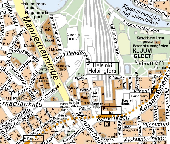2019
Type of resources
Available actions
Topics
Provided by
Years
Formats
Representation types
Update frequencies
Service types
Scale
Resolution
-

Helsingin kaupungin kantakartta on sijainniltaan tarkin paikkatietoaineisto Helsingin kaupungin alueelta. Kantakartta sisältää maastoa, rakennettua ympäristöä ja kiinteistöjaotusta kuvaavia tietoja. Aineisto on tuotettu ilmakuvauksien, maastomittauksien ja kiinteistötoimitusten sekä rakennuslupakäsittelyn toimenpiteiden kautta. Päivitys ja ylläpito jatkuvaa. Aineisto sisältää kiinteistöt, rakennukset, liikenneväylät, johtotiedot, nimistöt ja tunnisteet, aluejaotukset, vesistöt, korkeustiedot, maa- ja kasvipeitteen, runkopisteet sekä muut kohteet. Kantakartan pohjalta tuotetaan myös kaavojen pohjakartat. Aineisto on saatavilla WMS- ja WMTS-rajapintapalvelusta tasonimillä Kantakartta Kantakartta_harmaa Kantakartta_valkoinen Kantakartta_varillinen Kantakartta_rajat Kantakartan_maastotiedot Kantakartta_pohja Kantakartta_paakohteet
-
Kauniaisten kaupungin ylläpitämä osoiteaineisto. Jatkuva ylläpito tietokannassa, irroitus ja toimitus sopimuksen mukaan.
-
Helsingin kaupungin rakennuskieltokartta on Maankäyttö- ja rakennuslain 53 §:n mukainen kartta kaupungin alueella voimassa olevista rakennuskieltoalueista. Lain mukaisesti kunta voi määrätä rakennuskiellon alueelle, jolla asemakaavan laatiminen tai muuttaminen on vireillä. Kielto päättyy kun alueelle laadittu uusi asemakaava saa lainvoiman. Kielto on voimassa enintään kaksi vuotta. Kunta voi kaavoituksen keskeneräisyyden vuoksi pidentää kieltoaikaa kaksi vuotta kerrallaan. Rakennuskiellot määritellään kaavaprosessin kuluessa ja kaavaprosessista vastaa Kaupunkiympäristötoimialan Asemakaavoitus. Helsingin rakennuskieltokarttaa ylläpitää Kaupunkiympäristötoimialan Kaupunkimittauspalvelut. Aineiston ylläpito on jatkuvaa. Aineisto on saatavilla WMS- ja WFS-rajapintapalvelusta tasonimillä Rakennuskieltoalue_asemakaavan_laatimiseksi Rakennuskieltoalue_yleiskaavan_laatimiseksi
-

Helsingin kaupungin opaskartta on esitystavaltaan yleistetty opastava karttatuote, jonka ylläpitomittakaava on 1:10 000. Kartan alue kattaa koko Helsingin kaupungin maa-alueen ja osan merialueesta. Kartta sisältää mm. seuraavat tiedot: nimistö, kadut, tiet ja rautatieyhteydet, julkiset rakennukset, kerrostaloalueet, pientaloalueet, teollisuusalueet, metsä- ja pelto-alueet sekä kunnan rajat. Lisäksi kartassa on esitetty kaupunginosien ja osa-alueiden nimet sekä joitakin nähtävyyksiä. Aineistoa päivitetään jatkuvasti ja sitä ylläpidetään sähköisesti vektorimuodossa. Siitä tuotetaan sekä sähköisiä että painettuja karttatuotteita. Kartan hakuruudusto on yhtenäinen Espoon ja Vantaan opaskarttojen kanssa. Aineisto on saatavilla WMS ja WMTS-rajapintapalvelusta tasonimillä Opaskartta_Helsinki (myös WMTS) Opaskartta_Helsinki_harmaa Opaskartta_Helsinki_harvanimi Opaskartta_Helsinki_harvanimi_harmaa Opaskartta_Helsinki_4m Opaskartta_Helsinki_4m_harmaa
-

Lämmitysliitäntä on 1500 V sähköliitäntä, jonka avulla voidaan lämmittää henkilömatkustajavaunuja. 1500 V:n lämmitysliitännästä ilmoitetaan tunnus, omistaja, käyttöönottopäivämäärä, kuntotieto/lisätietoa ja käytössä olon tila (käytössä, ei käytössä, ei tiedossa) sekä sijaintiin liittyen sijaintiraidetunnus, ratakilometrisijainti ja sijainti arvio. 1500 V:n lämmitysliitännät kuuluvat ratapihan palveluihin ja varusteisiin. Aineisto kattaa Väyläviraston omistamat rautatiet. Aineiston lähdejärjestelmä on Ratainfratietojen hallintajärjestelmän ratakohteiden hallintasovellus (RATKO).
-
Jarrujen koettelujärjestelmällä voidaan suorittaa jarrujen puoliautomatisoitu tarkastus. Järjestelmä sisältää maastossa sijaitsevat laitteet: jarrujenkoettelulaite, oikeanlaiset liittimet ja oikean ilmanpaineen. Jarrujen koettelujärjestelmistä ilmoitetaan tunnus, tyyppi, omistaja, käyttöönottopäivämäärä, kuntotieto/lisätietoa ja käytössä olon tila (käytössä, ei käytössä, ei tiedossa) sekä sijaintiin liittyen sijaintiraidetunnus, ratakilometrisijainti ja sijainti arvio. Jarrujen koettelujärjestelmä kuuluu ratapihan palveluihin ja varusteisiin. Aineisto kattaa Väyläviraston omistamat rautatiet. Aineiston lähdejärjestelmä on Ratainfratietojen hallintajärjestelmän ratakohteiden hallintasovellus (RATKO).
-

Rautatieliikennepaikoista ilmoitetaan liikennepaikan toinen nimi, kaupallinen nimi, rautatieliikennepaikan id, liikennepaikan lyhenne, UIC-koodi, tyyppilyhenne, tyyppi, mahdolliset lisätiedot, kunta, liikenteenohjaus, radanpito, kohtaus, yksityisraiteet, vaihtotyömahdollisuus, VAK-ratapiha, mitoittava raidepituus (tavaraliikenne) sekä tavaraliikenne. Aineisto kattaa Väyläviraston omistamat rautatiet. Aineiston lähdejärjestelmä on Ratainfratietojen hallintajärjestelmän ratakohteiden hallintasovellus (RATKO). Aineisto päivittyy kerran viikossa.
-

Aineisto sisältää matkustajalaitureiden sijainti- ja rakennetietoja: ratanumero jolla matkustajalaituri sijaitsee, laiturin tunnus (muodostetaan liikennepaikan lyhenteestä ja laiturin numerosta), kuvaus, alkukm+m ja loppukm+m (laiturin alku- ja loppupisteen sijainti ratakilometrijärjestelmässä xxxx+xxxx), matala/korkea (laiturin korkeus), reuna, pinta, pituus (laiturin pituus metreinä kokonaislukuna), vaara-alue ja raiteen suurin nopeus (km/h). Matkustajalaiturit kuuluvat ratapihan paveluihin ja varusteisiin. Aineisto kattaa Väyläviraston omistamat rautatiet. Aineiston lähdejärjestelmä on Ratainfratietojen hallintajärjestelmän ratakohteiden hallintasovellus (RATKO).
-

Vesityspisteistä ilmoitetaan sijaintiin liittyen sijaintiraidetunnus ja ratakilometrisijainti. Vesityspisteet kuuluvat ratapihan palveluihin ja varusteisiin. Aineisto kattaa Väyläviraston omistamat rautatiet. Aineiston lähdejärjestelmä on Ratainfratietojen hallintajärjestelmän ratakohteiden hallintasovellus (RATKO).
-
The raw materials of forest chips in Biomass Atlas are small-diameter trees from first thinning fellings and logging residues and stumps from final fellings. The harvesting potential consists of biomass that would be available after technical and economic constraints. Such constraints include, e.g., minimum removal of energywood per hectare, site fertility and recovery rate. Note that the techno-economic potential is usually higher than the actual availability, which depends on forest owners’ willingness to sell and competitive situation. The harvesting potentials were estimated using the sample plots of the 11th and 12th national forest inventory (NFI11 and NFI12) measured in the years 2013–2017. First, a large number of sound and sustainable management schedules for five consecutive ten-year periods were simulated for each sample plot using a large-scale Finnish forest planning system known as MELA (Siitonen et al. 1996; Hirvelä et al. 2017). MELA simulations consisted of natural processes and human actions. The ingrowth, growth, and mortality of trees were predicted based on a set of distance-independent tree-level statistical models (e.g. Hynynen et al. 2002) included in MELA and the simulation of the stand (sample plot)-level management actions was based on the current Finnish silvicultural guidelines (Äijälä et al. 2014) and the guidelines for harvesting of energy wood (Koistinen et al. 2016). Future potentials were assumed to materialize when the industrial roundwood fellings followed the level of maximum sustainable removals (80.7 mill. m3 in this calculation). The maximum sustainable removals were defined such that the net present value calculated with a 4% discount rate was maximized subject to non-declining periodic industrial roundwood and energy wood removals and net incomes, and subject to the saw log removal remaining at least at the level of the first period. There were no constraints concerning tree species selection, cutting methods, age classes, or the growth/drain ratio in order to efficiently utilize the dynamics of forest structure. The potential for energywood from first thinnings was calculated separately for all the wood from first thinnings (Small-diameter trees from first thinnings) and for material that does not fulfill the size-requirements for pulpwood (Small-diameter trees from first thinnings, smaller than pulpwood). The minimum top diameter of pulpwood in the calculation was 6.3 cm for pine (Pinus sylvestris) and 6.5 cm for spruce (Picea abies) and broadleaved species (mainly Betula pendula, B. pubescens, Populus tremula, Alnus incana, A. glutinosa and Salix spp.). The minimum length of a pulpwood log was assumed at 2.0 m. The potentials do not include branches. The potentials for logging residues and stumps were calculated as follows: The biomass removals of clear fellings were obtained from MELA. According to harvesting guidelines for energywood (Koistinen et al. 2016) mineral soils classified as sub-xeric (or weaker) and peatlands with corresponding low nutrient levels were left out from the potentials. Finally, technical recovery rates were applied (70% for logging residues and 82-84% for stumps) (Koistinen et al. 2016; Muinonen et al. 2013) The techno-economical harvesting potentials were first calculated for nineteen Finnish regions and then distributed on a raster grid at 1 km × 1 km resolution by weighting with Multi-Source NFI biomasses as described by Anttila et al. (2018). The potentials represent time period 2025-2034 and are presented as average annual potentials in solid cubic metres over bark. References Äijälä O, Koistinen A, Sved J, Vanhatalo K, Väisänen P. 2014. Metsänhoidon suositukset. [Guidelines for sustainable forest management]. Metsätalouden kehittämiskeskus Tapion julkaisuja. Anttila P., Nivala V., Salminen O., Hurskainen M., Kärki J., Lindroos T.J. & Asikainen A. 2018. Regional balance of forest chip supply and demand in Finland in 2030. Silva Fennica vol. 52 no. 2 article id 9902. 20 s. https://doi.org/10.14214/sf.9902 Hirvelä, H., Härkönen, K., Lempinen, R., Salminen, O. 2017. MELA2016 Reference Manual. Natural Resources Institute Finland (Luke). 547 p. Hynynen J, Ojansuu R, Hökkä H, Salminen H, Siipilehto J, Haapala P. 2002. Models for predicting the stand development – description of biological processes in MELA system. The Finnish Forest Research Institute Research Papers. 835. Koistinen A, Luiro J, Vanhatalo K. 2016. Metsänhoidon suositukset energiapuun korjuuseen, työopas. [Guidelines for sustainable harvesting of energy wood]. Tapion julkaisuja. Muinonen E., Anttila P., Heinonen J., Mustonen J. 2013. Estimating the bioenergy potential of forest chips from final fellings in Central Finland based on biomass maps and spatially explicit constraints. Silva Fennica 47(4) article 1022. https://doi.org/10.14214/sf.1022. Siitonen M, Härkönen K, Hirvelä H, Jämsä J, Kilpeläinen H, Salminen O et al. 1996. MELA Handbook. 622. 951-40-1543-6.
 Paikkatietohakemisto
Paikkatietohakemisto